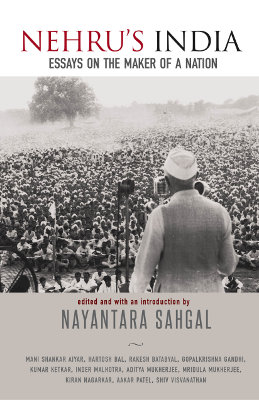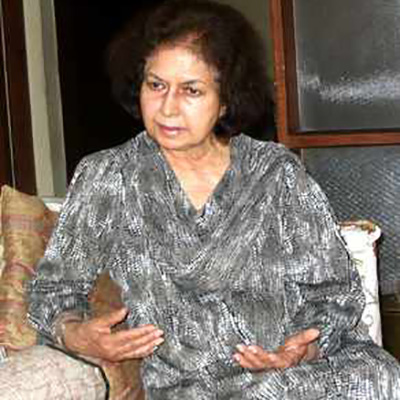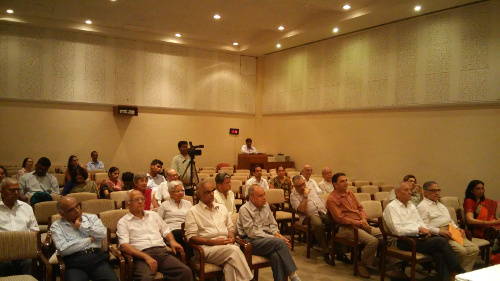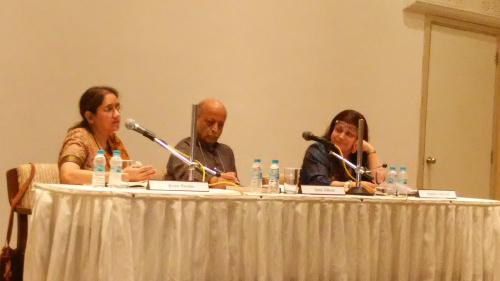At a time when the entire legacy of Nehru is being questioned – admittedly the pitch has been queered by the dubious, corrupt Congress party regime in recent times – it was appropriate that none other than the Nehru Centre in Mumbai held a discussion on his niece Nayantara Sahgal’s new, edited book Nehru’s India: Essays on the Maker of a Nation (Speaking Tiger, 192pp), which this columnist chaired.
Cover image of Nehru’s India: Essays on the Maker of a Nation. Pic: Speaking Tiger
All ten contributors and his niece in her introduction put up a strong defence of the first Prime Minister. Predictably, Mani Shankar Aiyar, a close buddy of his grandson, Rajiv, distinguishes Panditji not only as a man of action, but of the right action, as distinct from Vallabhai Patel. To elaborate this point further, he questions whether Nehru was the thinker and Sardar the doer, as is often stated nowadays.
Aiyar lists four great contributions of Nehru: Democracy, Secularism, Socialism and Non-alignment. He reminds us that of the 150 countries liberated in the world after 1947, India is the only one of its size and diversity to remain a democracy. One has only to cast an eye on our immediate neighbours, even across the Palk Straits, to drive home that point.
The one exception among the contributors is the journalist and author Hartosh Singh Bal, who was born in the 1960s and therefore didn’t treat Nehru as his Chacha or in other words, inherit his legacy.
Historians Aditya and Mridula Mukherjee note that at independence, over 8 out of every ten Indians (over 9 in the case of women) couldn’t read or write. An Indian could be expected to live for around 30 years, which meant the poor died much younger, echoing Susan George’s 1976 expose How the Other Half Dies: The Real Reasons for World Hunger (freely downloadable at https://www.tni.org/en/publication/how-the-other-half-dies).
Per capita income had been shrinking annually at 0.2 percent per year for the 30 years preceding 1947, encompassing the terrible Bengal famine. Farm output was shrinking at 0.72 percent per annum and foodgrains even faster at 1.14 percent. They write: “Nehru was to launch a brilliant multi-pronged strategy to lift India out of this morass which set an example to numerous other countries emerging out of colonialism after the Second World War.”

Author of Nehru’s India and Nehru's niece Nayantara Sahgal. Pic: Speaking Tiger
However, as the historians observe, neo-colonial authors like Tirthankar Roy, a labour expert formerly from the Tata Institute of Social Sciences and now in the economic history department of the London School of Economics (LSE) and his fellow LSE economist Lord Meghnad Desai, who was once a leftist, dismiss the colossal economic achievements of Nehru.
Desai characterises the first 44 years after independence, till the ushering in of economic liberalisation in 1991, as a ‘wasted opportunity.’ They probably derive this inference from the runaway success of the erstwhile Asian Tigers, now joined by the mother of all big cats, China, which substituted a protectionist policy towards domestic industry by export-led growth.
However, as has often been pointed out, all the Tigers, Japan in particular, also relied on fierce state-led industrial protectionism in their early growth years. Also, they weren’t faced by a unique Indian dilemma: how to propel a huge country like India, with half its population below the poverty line, into the 21st century?
Sunil Khilnani, in his The Idea of India (1997, Farrar, Strauss & Giroux, New York) writes: "It was by no means a foregone conclusion that, after 1947, India would embark on a path of planned industrialisation. Its huge agrarian economy was one of the most impoverished in the world; from Gandhi it had inherited a vision deeply opposed to the project of industrial modernity; and, although it possessed powerful industrial capitalists (at the end of the Second World War, India was the tenth largest producer of manufactured goods in the world), they did not form a united class strong enough to push through a project of industrialisation against a society of rentiers, farmers and traders.”
All capitalists like the Dalmias and Birlas made their killing by hoarding goods (hence, rentiers) during the First World War (the Tatas from opium sold to China) and investing their considerable surpluses in a wide range of industries.
While it is undeniable that post independence, in many cases, protectionist policies coddled Indian industrialists and shielded them from the searing winds of global competition, the state did help manufacturers to grow by capturing the “commanding heights of the economy” – the public sector – which laid the foundation for a somewhat delayed private sector take-off.
Rather than Nehruvian policies, or possibly only partly because of them, Indian industry chose to take the path of least resistance and look to short-term gain rather than invest for the future. Nowhere was this clearer than in the textile industry, which first was hamstrung by the British Raj protecting and promoting Manchester rather than Bombay or Ahmedabad.
However, cotton textile mill owners like the Tatas and Mafatlals chose to bleed their mills and invest their considerable profits into more lucrative industries in Mumbai such as heavy machinery, chemicals and petro-chemicals, in chronological order. When the time came in the 1970s and 1980s for the mills to compete with the Tigers, they couldn’t because their machinery was obsolete.
The Mukherjees state upfront that had India adopted a laissez faire policy in the 1950s, it would surely have headed towards becoming a “banana republic”. Indeed, at the Nehru Centre book discussion, a member of the audience asked panellists what would have happened had the Jan Sangh, the progenitor of the BJP, ruled India instead of the Congress in 1947.

The audience at the discussion, Nehru Centre, Mumbai. Pic: Nehru Centre Library
According to Aruna Pendse, who teaches politics at Mumbai University and was one of the two participants at the discussion, it would have almost certainly meant throwing in our fortunes with those of the US. That would have further meant participating in the Cold War instead of adhering to Nehru’s non-alignment.
She cited, as an exemplar of such kowtowing to US imperialism, the case of Thailand which, incidentally, has never been colonised but may be said to have felt the hot breath of neo-colonialism under US tutelage. It has served as an US army base for decades. During the Vietnam War in the 1960s and 1970s, it was an “R&R” (rest and recreation, partly a euphemism for prostitution) centre for American troops. That undermining of the country’s morals persists, as any visitor to the fleshpots of Patpong in Bangkok or the beaches of Pattaya can testify.
Moderating perspectives
Lest the reader infer that this columnist is a die-hard Nehruvian, one must set the record straight. All environmentalists believe that many of the so-called development policies that Nehru and his daughter pursued actually ended up adding to the misery of the marginalised.
In 1985, I published a book titled Temples or Tombs? Industry versus Environment: Three Controversies (Centre for Science & Environment) where I turned on its head Panditji’s oft-quoted remark (in Hindi, actually) when he opened the Bhakra-Nangal dam in 1954:
Probably nowhere else in the world is there a dam as high as this...As I walked around the site, I thought that these days the biggest temple and mosque and gurdwara is the place where man works for the good of mankind. Which place can be greater than this, Bhakra-Nangal?
The fact is the emphasis on such infrastructure and heavy industry – the commanding heights – were at the cost of agriculture, village crafts and small enterprises, which explains why much of India is still mired in poverty.
Although Nehru once said that “Everything can wait but not agriculture”, it took the food crisis of the 1960s which propelled us towards reliance on US “ship-to-mouth” PL 480 grain aid shipments, to serve as a wake-up call.
Ironically, it was only through another US-inspired innovation, the Green Revolution in wheat, that the country became self-sufficient in food (though it became reliant on input-intensive agriculture, now veering into cash crops instead of food).
Again, Nehru’s attempted land reforms were so necessary for farm output to increase by allowing sharecroppers or the landless to acquire their own two or so acres. But at best, these were half-baked; at worst, the contemporaneous Gandhian Bhoodan (voluntary land donation) movement hardly dented the problem.
Still, the failed transformation of agriculture took place in a democratic framework, unlike our Big Neighbour to the East, China, where countless peasants – demographers put it between 18 and 32 million – died in “The Great Leap Forward” from farming to industry.
Daniel Thorner -- the renowned American economist who fled his native country during the McCarthy era, made India his home and introduced peasants in the study of agriculture along with D.D. Kosambi and R.S. Sharma -- once pointed out that India achieved on the farm front in just 21 years after freedom what it had taken the previous 200 years to accomplish.
Incidentally, Nehru himself said, in 1948, “What is a young man’s ambition today?...They think of becoming economists, because an economist plays a big part in the modern world.”
Current debates
In today’s India, more than Nehru’s economic policies, it is his political and sociological inclinations, particularly on Kashmir and secularism that have come under severe fire. The late poet A.K. Ramanujam once likened Nehru’s penchant for diversity to what an Irish politician said about trousers. The very same vestment was singular at the top, but plural at the bottom.
In somewhat the same vein, ecologists believe that tropical ecosystems harbour the most diverse life on the planet; by extrapolating this to India’s society, the more diverse it is, the more robust it will turn out to be.

At the discussion- Aruna Pendse( left) , Darryl D'Monte (center) and Rakesha Chaturvedi (right). Pic: Nehru Centre Library
At the Nehru Centre book discussion, a discordant note was struck by the other panellist, Rakesha Chaturvedi, who teaches junior college at the NSS Hill Spring International School in Mumbai. She called for the integration of the minorities into the “mainstream” and asserted that the Rashtriya Swayamsevak Sangh shouldn’t be blamed for Muslim fundamentalism.
By contrast, Bal elaborates on the perceived wrongs on the part of the Hindu right in his chapter titled “The Truth-teller”. He writes, “The RSS’s worldview has internalised the idea of defeat by colonial powers, and now seeks refuge at hostility at everything suggestive of that defeat.” He goes beyond the Raj to cite the psychological wounds inflicted by Islamic rulers and adds: “The RSS’ hatred of Christianity and Islam is only a manifestation of a much larger malaise.”
Upping the ante, Chaturvedi advocated splitting Pakistan into four separate ethnic nations which alone would ward off the unwanted attentions towards India of the Inter-Services Intelligence (ISI) agency. Otherwise, Pakistan was held together only by the hatred of India. “India is a nation with a military, Pakistan a military nation,” she remarked.
Pendse replied that dismembering Pakistan would be most unsustainable for that country. Besides, what kind of nation would we then have on our border? It would bring the Islamic State of Iraq & Syria (ISIS) to our very doorstep, and considerably heighten the threat of terrorism.
She asked the audience to remember the threat posed by the separatist movement of Khalistan. Had he been alive, Nehru -- who believed in the five principles of Panchseel – would never have interfered with the internal affairs of his neighbours in the aggressive manner that Chaturvedi spelt out.
In conclusion, I remarked that after two visits to Pakistan, I have learnt what Pakistanis think of India. They perceive us as this huge country, with the fourth or so largest army in the world and one which has beaten Pakistan to becoming a nuclear power.
I could have added that if anything, Pakistan suffers far worse Islamic terrorist attacks than this country, almost on a weekly basis. I could have further added, quoting Gandhiji, someone who is also the Hindu Right’s bête noire: “An eye for an eye only ends up making the whole world blind."
These times call for a much greater and reasoned adherence to Nehru’s cherished ideals than ever before.
























